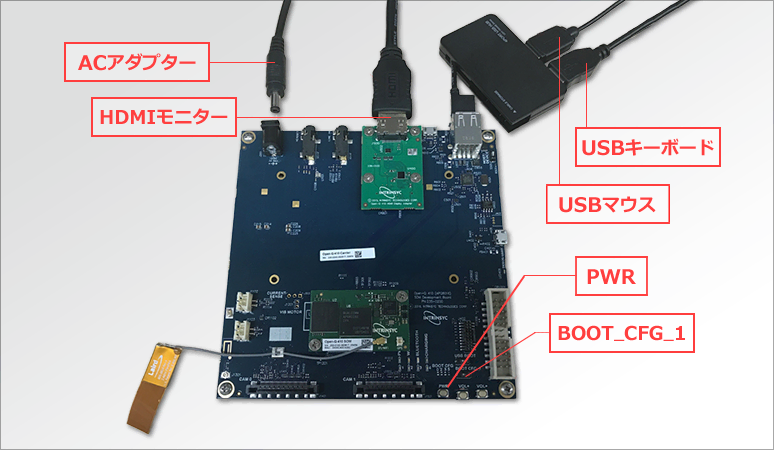IoT x Snapdragon
Qualcomm社のSnapdragonといえばスマートフォンやタブレット等のモバイル向けSoCとして業界をリードする存在として広く知られていますが、昨今ではIoTや組み込み機器向けにご検討頂くケースも増えてきているような印象を受けます。
一方で、いざSnapdragonを使ってみよう!と思っても、そもそもどんなことが出来るのか、どうやって使うのか、イメージを掴むことが出来ずになかなか評価に踏み切れないというケースも多いように感じます。
そこで本記事では、Snapdragonをベースに様々なデモを構築しながら、その手順や関連する技術などについて紹介することで、Snapdragonを使ったアプリケーション開発に興味を持って頂ければと思っています。
さらには、実際に開発ボードなどに触れていただき、様々なIoT機器にSnapdragonを検討するきっかけにして頂ければと思います。
マクニカではSnapdragonの評価を手軽に行って頂けるよう、Snapdragonを搭載したIntrinsyc社の開発用ボードを取り扱っています。
今回は、そのラインナップの中からOpen-Q™ 410 Development Kitというボードを使用しLinux OSをインストールする方法を紹介していこうと思います。
デモ機材の準備
- Open-Q™ 410 Development Kit(以下Devkit)
- USBハブ
- USBマウス
- USBキーボード
- HDMIモニター
- SDカード
- Windows PC (SDカードにLinuxのイメージファイルをダウンロードするために使用)
下図のようにそれぞれの機器を接続しておきます。

Linux(Debian)のインストール
1. SDカードにLinuxブート用のイメージファイルを書き込む
96Boardsという団体がリリースしているLinuxのイメージファイル(stretch版)をダウンロードします。
96Boardsのウェブサイトにアクセスし、zipフォルダ( dragonboard410c_sdcard_install_debian-283.zip )を解凍すると、イメージファイル( -db410c_sd_install_debian.img )が入っています。
イメージファイルはそのままではリムーバブルデバイスに書き込むことが出来ないので、Win32DiskImagerなどのソフトを使ってSDカードに書き込みます。
※この作業はWindows PCで行いました。
2. SDカードからDevkitにLinuxをインストール
イメージファイルを入れたSDカードをPWR Off状態でDevkitに挿入します。
ここでSDカード内にあるイメージでDevkitをブートするためにBOOT CFG_1のスイッチをOnに入れた状態にし、PWRを長押ししてPWR Onにします。
PWR Onすると、モニター上に図2のようなウィンドウが表示されるので、一番左のInstallアイコンを押します。
図3のような画面が現れ、“Yes”を選択するとインストールが始まります。
何分か放置し、図5のような画面が出たらインストール成功です。
SDカードを取り出し、“OK”を押した後、DevkitをPWR Offします。
BOOT_CFG_1のスイッチをOffに戻してから再びDevkitのPWRを長押ししてPWR Onします。これでLinuxのインストールは完了です。
Linuxインストール完了後の各種設定
キーボードレイアウト変更(日本語キーボードを使用する場合)
Preferences -> LXQt settings -> Keyboard and Mouse
Keyboard Layout -> “Add”で”Japanese”を追加し、”up”を押して”English(US)”より優先度を上にする。
無線用ファイルの置き換え
Open-Q Devkitは無線関連の初期設定がAndroid用になっているので、その他のOSで使用する際にはIntrinsycのウェブサイトからボードデータファイルを取得して置き換える必要があります。
ボードデータファイルを保存したUSBメモリをDevkitに挿入、QTerminalで下記コマンドを実行し、ファイルを置き換えます。その後DevkitをRebootします。
(なお、ボードデータファイルの入手にはIntrinsycサポートサイトへの会員登録が必要となります。この作業はWindows PCで行いました。)
$ sudo cp <メモリのパス>/WCNSS_qcom_wlan_nv.bin /lib/firmware/wlan/prima/WCNSS_qcom_wlan_nv.binパッケージリストのアップデート
インストールしたばかりのLinuxにはパッケージをインストールする際に参照するインデックスファイルが存在しないのでパッケージをインストールすることが出来ません。
そこで、Wifi接続後にQTerminalを起動し下記コマンドでパッケージリストを最新版にアップデートします。
$sudo apt-get updateこれでLinuxを動かす準備が出来ました。
これからこのLinuxをインストールしたDevkitを使って色々なデモを実装していきたいと考えています。
おすすめ記事/資料はこちら
メーカーサイト/その他関連リンクはこちら
Qualcomm Snapdragon is a product of Qualcomm Technologies, Inc. Qualcomm and Snapdragon are trademarks of Qualcomm Incorporated, registered in the United States and other countries.
